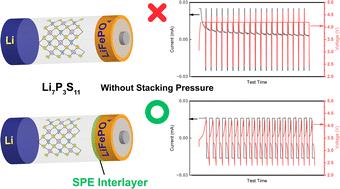金属卤化物掺杂和聚合物界面的协同作用使所有固态锂电池的电化学性能得到改善
IF 9.5
2区 材料科学
Q1 CHEMISTRY, PHYSICAL
引用次数: 0
摘要
硫化物固态电解质由于具有较高的离子电导率和良好的力学性能,是全固态锂金属电池(ASSLBs)的有希望的候选材料,具有更高的能量密度和实用安全性。然而,它们的实际集成受到低临界电流密度(CCD)、窄电化学稳定窗口和电极高阻抗的阻碍。在此,我们证明了用氯化锆(ZrCl4)掺杂硫化磷锂(Li7P3S11)固体电解质可以显著提高其电化学性能。与先前报道的掺杂策略不同,ZrCl4掺杂独特地将双掺杂剂(Zr4+和Cl−)引入Li7P3S11基体中。密度泛函理论(DFT)和从头算分子动力学(AIMD)模拟表明,Zr4+离子增加了动态结构的灵活性,而Cl−离子产生了额外的Li+空位,共同提高了结构稳定性和离子电导率,超出了单元素掺杂策略的能力。ZrCl4掺杂量优化后,Li7P3S11的CCD从0.55 mA cm−2提高到1.7 mA cm−2,离子电导率从1.8 × 10−3 S cm−1提高到3.0 × 10−3 S cm−1。与对照电池相比,掺杂电解质的Li/Li对称电池在0.1 mA cm−2下表现出更好的循环稳定性。此外,在阴极和固体电解质之间的界面上使用了一种薄的固体聚合物电解质(SPE),以实现全电池的无堆叠压力运行。与未掺杂固体电解质(SE)的锂/LiFePO4 (LFP)全电池相比,使用掺杂固体电解质(SE)和SPE阴极电解质的锂/LiFePO4 (LFP)全电池表现出稳定的性能。由于掺杂Li7P3S11而增强的锂枝晶抑制和电化学性能的改善,以及由于添加SPE作为阴极物而实现的无堆叠操作,将为ASSLB技术的发展增添巨大的潜力。本文章由计算机程序翻译,如有差异,请以英文原文为准。

Synergy of metal halide doping and a polymeric interface enables improved electrochemical performance of all solid-state Li batteries
Sulfide solid-state electrolytes are promising candidates for all-solid-state lithium metal batteries (ASSLBs) having higher energy density and practical safety due to their high ionic conductivity and favorable mechanical properties. However, their practical integration is hindered by low critical current density (CCD), a narrow electrochemical stability window, and high impedance with electrodes. Herein, we demonstrate that doping lithium phosphorus sulfide (Li7P3S11) solid electrolyte with zirconium chloride (ZrCl4) significantly enhances its electrochemical performance. Unlike previously reported doping strategies, ZrCl4 doping uniquely introduces dual dopants (Zr4+ and Cl−) into the Li7P3S11 matrix. Density functional theory (DFT) and ab initio molecular dynamics (AIMD) simulations reveal that the Zr4+ ions increase dynamic structural flexibility, while Cl− ions create additional Li+ vacancies, collectively enhancing structural stability and ionic conductivity beyond the capacity of single-element doping strategies. Optimized doping content of ZrCl4 improved the CCD of Li7P3S11 from 0.55 mA cm−2 to 1.7 mA cm−2, while the ionic conductivity improved from 1.8 × 10−3 S cm−1 to 3.0 × 10−3 S cm−1. Li/Li symmetrical cells with doped electrolyte exhibited improved cycling stability at 0.1 mA cm−2 compared to the control counterparts. Furthermore, a thin solid polymer electrolyte (SPE) was used at the interface between the cathode and solid electrolyte to enable the stack pressure free operation of full cells. Li/LiFePO4 (LFP) full cells using doped solid electrolyte (SE) in combination with SPE catholyte demonstrated stable performance compared to undoped SE based cells. The enhanced Li-dendrite suppression and improved electrochemical properties due to doped Li7P3S11 and the stack free operation due to the addition of SPE as catholyte will add significant potential for advancing ASSLB technology.
求助全文
通过发布文献求助,成功后即可免费获取论文全文。
去求助
来源期刊

Journal of Materials Chemistry A
CHEMISTRY, PHYSICAL-ENERGY & FUELS
CiteScore
19.50
自引率
5.00%
发文量
1892
审稿时长
1.5 months
期刊介绍:
The Journal of Materials Chemistry A, B & C covers a wide range of high-quality studies in the field of materials chemistry, with each section focusing on specific applications of the materials studied. Journal of Materials Chemistry A emphasizes applications in energy and sustainability, including topics such as artificial photosynthesis, batteries, and fuel cells. Journal of Materials Chemistry B focuses on applications in biology and medicine, while Journal of Materials Chemistry C covers applications in optical, magnetic, and electronic devices. Example topic areas within the scope of Journal of Materials Chemistry A include catalysis, green/sustainable materials, sensors, and water treatment, among others.
 求助内容:
求助内容: 应助结果提醒方式:
应助结果提醒方式:


